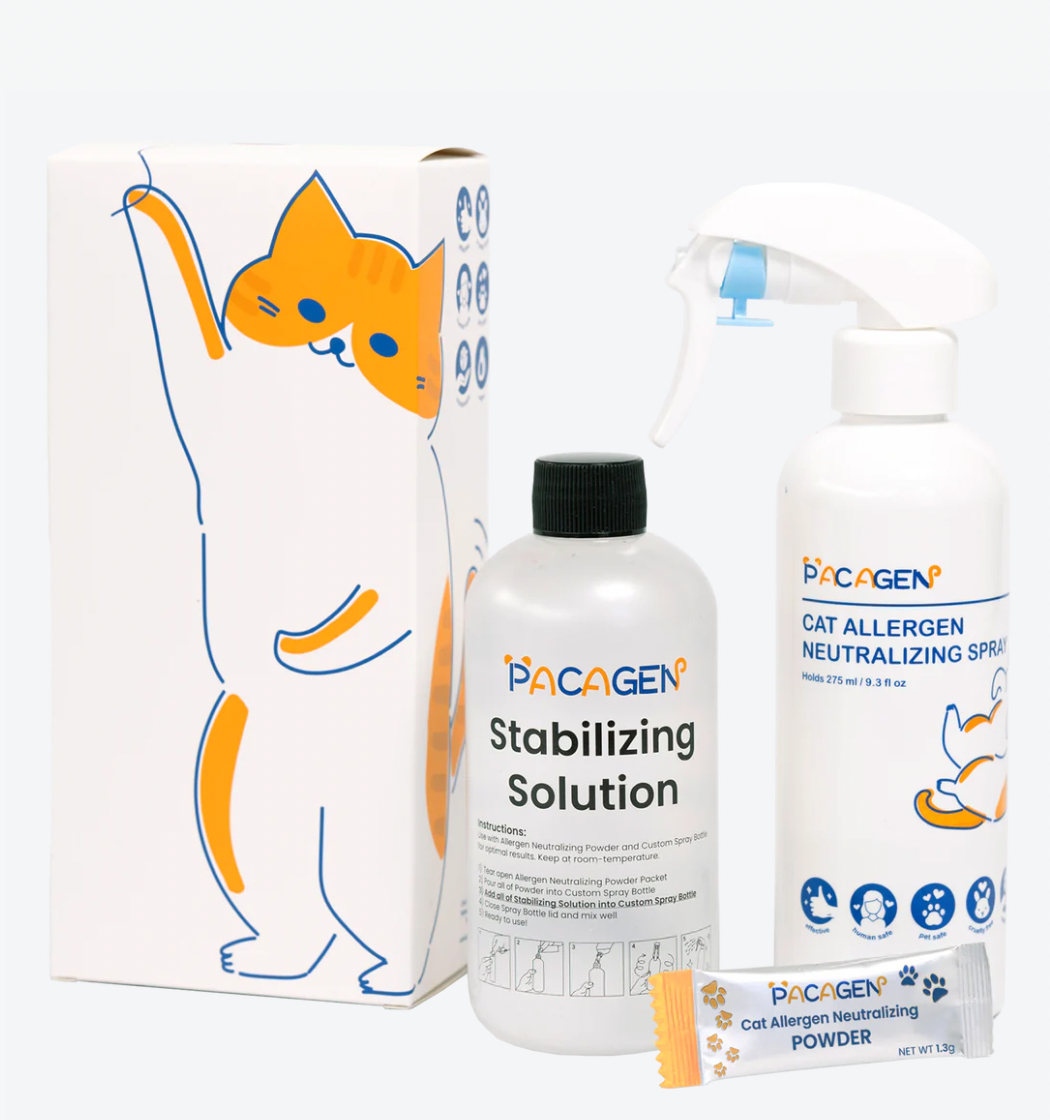Have you ever lived with an animal you’re actively allergic to? Or is your partner allergic to your beloved furry friend? It’s not easy (or, let’s face it, sexy) to cuddle in bed or watch a movie on the couch while sneezing nonstop.
But how do these allergies function in the body — and what can we do if we love our fluffy pets, but don’t love being short of breath whenever we nuzzle them? We spoke to veterinarian Andrew Findlaytor, DVM, to better understand cat allergies, which can be irritating, all-consuming, and even dangerous. We’ll also talk about a product that can neutralize your cat’s allergens and help with your allergic response, making it possible — and even simple — to stop all that wheezing and itching for good.
How do cat allergies work?
“A common misconception is that cat hair causes allergies,” Dr. Findlaytor told Katie Couric Media. “That’s definitely not the case: What people are actually allergic to is this nasty little protein called Fel d 1, which is most frequently found in cat saliva.”
If you live with a cat, then you already know that your furry pal is licking itself constantly as a way to maintain cleanliness. That means the cat is frequently coating itself in allergy-inducing saliva, which is why you can’t stop sneezing when you’re in the same room as Mr. Whiskers. It’s also worth noting that there isn’t (yet) a labradoodle equivalent of a cat breed; in other words, there’s no such thing as a hypoallergenic cat. So there’s really no avoiding this allergy-causing protein, regardless of what type of cat you have.
So how does that cat saliva end up infiltrating your senses? “The protein in cat saliva can float all throughout the environment,” Dr. Findlaytor says. “That’s what causes the allergies.”
What is pet dander and can it cause allergies?
“Dander is definitely a factor because, at its core, any animal that has fur also has dander. So again, particularly for cats who groom themselves frequently, that dried skin is associated with potential ways to spread the protein that causes allergies.”
And yes, if you’re wondering, that does mean that long-haired cats can cause more allergy flare-ups than short-haired cats, simply because there’s more surface area for them to coat with the allergy-causing protein.
How to deal with cat allergies
Cat allergies tend to manifest in the same way as other allergies, Dr. Findlaytor notes. If you’re allergic and walk past a particularly silky kitten, you might sneeze, become congested, have watery eyes and a runny nose, or even suffer an asthma attack. It’s obviously not a very pleasant experience, and in some instances, it can be life-threatening.
Luckily, Pacagen, which leverages biotechnology in the pet-care industry, recently released their Cat Allergen Neutralizing Spray that helps prevent sneezing, coughing, wheezing, and throat-clearing. “As a veterinarian, I find Pacagen to be really exciting,” Dr. Findlaytor says. “The company has a special proprietary chemical that basically binds with the allergy-causing protein and alters it so that it can’t cause an allergy flare-up.” Instead of taking over-the-counter medications that work to reactively address your symptoms after they’ve begun, this home-cleaning spray can work proactively to ensure that the symptoms never manifest at all. That way, your cat will keep on cleaning itself, and someone with allergies will be able to coexist alongside them without suffering a sneezing fit every five minutes. “With Pacagen, the hair can still exist in the area, but it’s not going to get all the way into our system — and even if it does, it’s not going to bother us.”
How to use Pacagen’s Cat Allergen Neutralizing Spray at home
The only thing better than learning that your partner won’t wake up in the middle of the night with runny eyes and a scratchy throat? Learning how little time it will take to neutralize the cat allergens in your home.
Pacagen’s Cat Allergen Neutralizing Spray works just like an odor-neutralizing spray: Just spray the areas of your home where your cat spends most of their time (like a cat tower, your own bed, living room furniture, or — gasp — the kitchen counter) and you’re good to go. As for how often you should spray down the area, it depends on your unique situation.
The best way to get started, Dr. Findlayter says, is to first give your home a deep clean, so you’re starting with an allergen-free foundation. Then you can start your Pacagen routine.
“I would advise people to use the spray every other day, to start,” Dr. Findlaytor explains. “Then you can scale up or down depending on how your allergies are.” Then you can cuddle up to Mr. Whiskers, incident-free.

Pacagen
And what better way to begin than with a special discount code? Type KCMMay2024 into the promotions box at checkout for a little treat to get you started.









